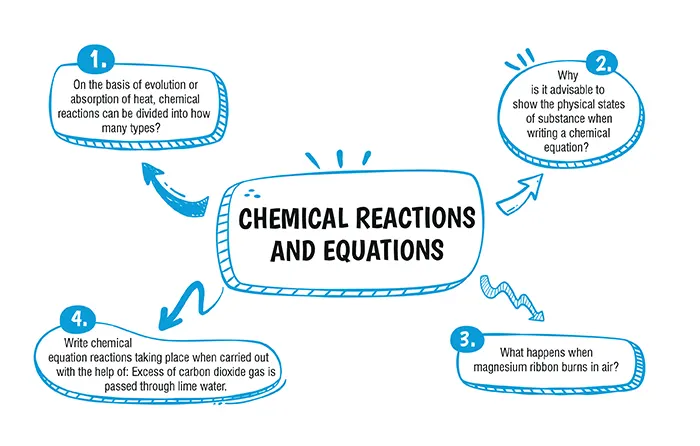Table of Contents

Ans. (d)
Explanation:
A double displacement reaction is a type of chemical reaction where two compounds react, and the cations (positive ions) and anions (negative ions) of the two reactants exchange places, resulting in the formation of a precipitate, gas, or water as one of the products.
For example, in the reaction between copper sulphate (CuSO₄) and hydrogen sulphide (H₂S):
Ans. (a) Two
Explanation:
Chemical reactions can be divided into 2 types on the basis of evolution or absorption of heat in a chemical reaction.
1) Exothermic Reactions - The chemical reactions in which energy is evolved either in the form of light or heat.
Example- CaCl_2 (s) + 2(H_2O) \rightarrow Ca(OH)_2 (aq) + 2 HCl (g) + heat.
2) Endothermic Reactions - The chemical reactions in which energy is absorbed either in the form of heat or light.
Example- 6CO_2 (g) + 6 H_2O (g) + heat \rightarrow C_6H_{12}O_6 + 6O_2 (g).
Explanation:
It is advisable to show the physical state of the substance to make it more informative and to emphasise that those reactions occur in that manner only under those conditions. Hence, physical states of reactants and products are mentioned while writing a chemical equation.
Explanation:
When magnesium ribbon burns in air, it combines with the oxygen to form magnesium oxide.
Explanation:
Lime water is solution of Calcium Hydroxide almost as clear as water When Carbon dioxide gas is passed through it it turns milky because in this chemical reaction Calcium Carbonate is Formed which is insoluble in water So these insoluble particles are spread throughout the solution These particles being white in colour the solution appears to be milky.
When excess CO_2 is added, it reacts with calcium carbonate ( CaCO_3) and water (H_2O) to form calcium bicarbonate Ca(HCO_3)_2 and since it is soluble in water, it dissolves in it making the solution clear again.
| Chapter No. | Chapter Name |
|---|---|
| Chapter 1 | Chemical Reactions and Equations |
| Chapter 2 | Acid, Bases and Salts |
| Chapter 3 | Metals and Non-Metals |
| Chapter 4 | Carbon and its Compounds |
| Chapter 5 | Life Processes |
| Chapter 6 | Control and Coordination |
| Chapter 7 | How do Organisms Reproduce |
| Chapter 8 | Heredity |
| Chapter 9 | Light : Reflection and Refraction |
| Chapter 10 | The Human Eye and the Colourful world |
| Chapter 11 | Electricity |
| Chapter 12 | Magnetic Effects of Electric Current |
| Chapter 13 | Our Environment |
| Chapter Wise Important Questions for CBSE Board Class 10 Science |
|---|
| Chemical Reactions and Equations |
| Acid, Bases and Salts |
| Metals and Non-Metals |
| Carbon and its Compounds |
| Life Processes |
| Control and Coordination |
| How do Organisms Reproduce |
| Heredity |
| Light : Reflection and Refraction |
| The Human Eye and the Colourful world |
| Electricity |
| Magnetic Effects of Electric Current |
| Our Environment |
CBSE Important Questions Class 10
ICSE Important Questions Class 10
CBSE Important Questions Class 10
ICSE Important Questions Class 10